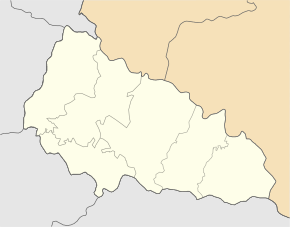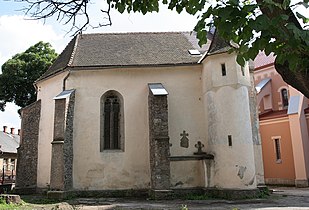Mukachevo
| Mukachevo | ||
| Мукачево | ||

|
|
|
| Basic data | ||
|---|---|---|
| Oblast : | Zakarpattia Oblast | |
| Rajon : | District-free city | |
| Height : | 128 m | |
| Area : | 27 km² | |
| Residents : | 77,300 (December 2004) | |
| Population density : | 2,863 inhabitants per km² | |
| Postcodes : | 89600 | |
| Area code : | +380 3131 | |
| Geographic location : | 48 ° 27 ' N , 22 ° 43' E | |
| KOATUU : | 2110400000 | |
| Administrative structure : | 1 city | |
| Mayor : | Andrey Balogh | |
| Address: | вул. Пушкіна 2 89600 м. Мукачево |
|
| Website : | https://mukachevo-rada.gov.ua | |
| Statistical information | ||
|
|
||
Mukachevo ( Ukrainian Мукачево - until 2017 Мукачеве Mukachev ; German Munkachev ) is a city in the western Ukrainian Oblast of Transcarpathia and the administrative center of Mukachevo Raion .
Geographical location
Mukachevo is located on the edge of the Carpathian Forest at an altitude of 176 m on the central reaches of the Latorica River , 250 km southwest of Lviv . Mukachevo is close to the borders with Poland (200 km), Slovakia (90 km), Hungary (40 km) and Romania (110 km). The most famous sight of the city is the Palanok Castle , which was built in the 14th century.
Name and territories of the city
Due to the varied history, the city has different names in different languages: German Mukachevo , Ukrainian Мукачево Mukachevo , Мукачеве Mukachevo or Мукачів Mukachevo , Rusyn Мукачово Mukatschowo , Russian Мукачево Mukachevo , Hungarian Munkács , Czech and Slovak Mukačevo , Hebrew מונקאטש Minkatsch and Romanian Munceag or Muncaci (archaic Muncaciu ).
| Period | Affiliation |
|---|---|
| 9th century | Probably Great Moravia |
| 10th to 11th centuries | In or on the border of the Kievan Rus |
| 10/11 Century to 1538 | Kingdom of Hungary ( Bereg County ) |
| 1538 to the end of the 17th century | Alternating between the Principality of Transylvania and the Kingdom of Hungary (Bereg County) |
| Late 17th century to 1918 | Empire of Austria , since 1867 Austria-Hungary , Kingdom of Hungary (Bereg County) |
| 1919-1938 | Czechoslovakia ( Podkarpatská Rus ) |
| 1938-1945 | Kingdom of Hungary (Bereg County) |
| 1945-1991 | Soviet Union (also part of the Ukrainian SSR since 1946 ) |
| 1991 until today | Republic of Ukraine (Sakarpatska Oblast / Zakarpattia Oblast ) |
history
Hungarian period (10th / 11th century to 1919)
In the Kingdom of Hungary , the city was part of the Bereg County .
The castle of Munkács (today Palanok Castle ), like most castles in this area, was built by the Hungarian King Béla IV in the 13th century after the Mongol invasion to protect the eastern borders of Hungary.
In 1445 the city was declared a royal free city.
The most famous owners of the castle were the Rákóczi family. After the end of the Hungarian uprising against the Habsburgs (1711 Peace of Sathmar ) led by Ferenc II Rákóczi , the Rákóczis lost the castle.
In 1726 the Habsburgs transferred the castle with the town and the surrounding area to the Austrian Schönborn family , who also settled many Germans in Munkács. During this time the city expanded in terms of area and economy.
From the end of the 18th century until 1897 the castle was used as a barracks and prison.
During the Austro-Hungarian monarchy, the city was always referred to by its Hungarian name Munkács.
20th century

In 1919 , the city came to the newly founded Czechoslovakia in connection with the Paris suburb agreements and was now called Mukačevo . In November 1938, the city came back to the Kingdom of Hungary with the First Vienna Arbitral Award , which Hitler dictated . Germany's opponents of the war regarded the arbitration award as null and void from the start.
In the interwar period , the Jewish population was over 40%, which was 13,488 at the beginning of 1941. After the German occupation of Hungary in March 1944, the Hungarian administration ordered a ghetto for the Jewish population of the city and a second for those of the surrounding area in April. By the end of May 1944, the entire Jewish population was deported to Auschwitz , where over 80% were murdered. On October 26, 1944, the city was captured by the Red Army during the Eastern Carpathian Operation .
After the end of the Second World War , the city came to the Soviet Union , when Carpathian Ukraine was added to the Ukrainian Soviet Socialist Republic without questioning the re-established Czechoslovakia .
It came as a result of strong industrialization extensive incorporations, the formerly independent places Palanok (German rarely Ukrainian Паланок, plank Castle , Hungarian Várpalánka ) Roswyhowo (Ukrainian Росвигово, Russian Росвегове / Roswegowe , Hungarian Oroszvég ) Pidhorod (Ukrainian Підгород, Russian Подгород / Podgorod, German seldom Croatian village , Hungarian Munkácsváralja ), Pidmonastyr (Ukrainian Підмонастир, Russian Подмонастирь / Podmonastir , Hungarian Klastromalja ) and Pidhorjany (Ukrainian Підгорянja, Slovakian Підгорянja, Slovene, Підгорянja , parts of the town of Podgorany, in Russian , since January 11th, Підгорянja, Slovene, Podgorian region, Podhegy, in Russian, Подгоряни, Podhegy are in the Hungarian region since January 11th.
After the collapse of the Soviet Union , the city became part of the now independent Ukraine.
Economy and Infrastructure
The city is the hub between the European Union and Eastern Europe . Mukachewo is the location of factories from the beer, wine, tobacco, textile, furniture and food industries. The largest bazaar in the Transcarpathian Province takes place in the city center.
- Views of Mukachevo
population
In Mukachevo, Ukrainians make up the majority of the population (77.1%). The largest minorities are Russians (9.0%), Magyars (8.5%), Germans (1.9%) and Roma (1.4%) (data from 2001).
sons and daughters of the town
- Mikuláš Tóth (1833–1882), Greek Catholic bishop of the Prešov eparchy
- Mihály von Munkácsy (1844–1900), Hungarian painter
- Stefan Winkle (1911–2006), physician and microbiologist
- Johanna Nestor (1917–2012), Austrian ambassador
- Rio Preisner (1925–2007), Czech poet, philosopher, translator and scholar
- Ludvík Ráža (1929–2000), Czech director
- Jack Garfein (1930–2019), American theater and cinema director and actor
- Lolita Miljawskaja (* 1963), Russian Estrada singer and actress
- Mykola Petro Lutschok (* 1974), Ukrainian religious, auxiliary bishop in Mukacheve
- Kamilla Senjo (* 1974), German journalist and presenter
- Svyatoslaw Wakarchuk (* 1975), Ukrainian singer, songwriter and social activist
religion

Mukachevo is the seat of two Catholic dioceses, the Roman Catholic diocese of Mukachev and the Ruthenian Greek Catholic eparchy of Mukachev .
climate
Summers are very warm (an average of 23 to 25 ° C in July) and winters are cold (−3 to −4 ° C in January). Autumn is mostly dry and mild. April is the wettest month with frequent rainfall.
Town twinning
-
 I. District , Budapest , Hungary (since 2014)
I. District , Budapest , Hungary (since 2014) -
 Mátészalka , Hungary
Mátészalka , Hungary -
 Kharzysk , Ukraine
Kharzysk , Ukraine
literature
- Munkács , in: Guy Miron (Ed.): The Yad Vashem encyclopedia of the ghettos during the Holocaust . Jerusalem: Yad Vashem, 2009 ISBN 978-965-308-345-5 , pp. 504 f.
Web links
Individual evidence
- ↑ Верховна Рада України; Постанова від 23.05.2017 № 2065-VIII Про перейменування міста Мукачеве Закарпатської області
- ↑ Archived copy ( Memento of the original from April 13, 2009 in the Internet Archive ) Info: The archive link was inserted automatically and has not yet been checked. Please check the original and archive link according to the instructions and then remove this notice.
- ↑ National composition of the population - Zakarpattia on the website of the State Statistics Committee of Ukraine; accessed on September 12, 2019 (Ukrainian)










